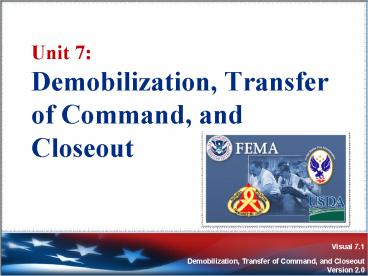Unit 7: Demobilization, Transfer of Command, and Closeout - PowerPoint PPT Presentation
1 / 24
Title:
Unit 7: Demobilization, Transfer of Command, and Closeout
Description:
For each ICS position you have identified for this incident, identify: 1) who they work for, 2) their major responsibilities, and 3) who works for them. – PowerPoint PPT presentation
Number of Views:120
Avg rating:3.0/5.0
Title: Unit 7: Demobilization, Transfer of Command, and Closeout
1
Unit 7 Demobilization, Transfer of Command,
and Closeout
2
Unit Objectives (1 of 2)
- Describe the importance of demobilization
planning. - Identify the impact of agency-specific policies,
procedures, and agreements upon demobilization
planning. - Identify the ICS titles of personnel who have
responsibilities in developing and implementing
the demobilization plan and list their duties.
3
Unit Objectives (2 of 2)
- List the major sections in a demobilization plan.
- Identify the need for transfer of command or
closeout. - Identify the process involved in a closeout
meeting.
4
Demobilization
- Demobilization
- Is the release and return of resources that are
no longer required. - May occur at any time during or after the
incident/event.
5
Demobilizing Nonexpendable and Expendable
Resources
- Nonexpendable Resources
- Account for resources returned.
- Restore resources to functional capability.
- Replace broken and/or lost items.
- Expendable Resources
- Account for resources used.
- Reimburse for expendable items used.
- Return and restock items.
6
Demobilization Challenges
What challenges are related to demobilization?
7
Demobilization Planning Benefits
- Demobilization planning helps to
- Eliminate waste.
- Eliminate potential fiscal and legal impacts.
- Ensure a controlled, safe, efficient, and
cost-effective release process.
8
Agency Policies and Procedures
- Demobilization policies and procedures depend on
the size of the incident and may involve - Fiscal/legal policies and procedures.
- Work rules.
- Special license requirements.
- Other requirements.
9
Who Does What?
Incident Commander
Operations Section
Planning Section
Logistics Section
Finance/Admin Section
10
Demobilization Plan Information Needs
What Information Is Needed? Who Provides?
Excess resources release priorities All Supervisors and Managers
Plan development resource information demobilization process Planning Section
Continuing needs for tactical resources Operations Section
Transportation availability communications maintenance Logistics Section
Claims, time records, and costs of individual resources that are a factor in release Finance/Admin Section
Agreements regarding other agency resources Liaison Officer
Physical condition of personnel physical needs adequacy of transportation Safety Officer
Return and reassignment of resources Agency Dispatch/Ordering Centers
11
Demobilization Plan Sections
Release Priorities
12
Activity Reviewing the Demobilization Plan
- Instructions Working as a team
- Review the sample demobilization plan for the
Yorktown Incident found in your Student Manuals. - Next, determine whether the five elements
required for a demobilization plan are adequately
addressed in the sample. - Record your work on chart paper as follows
- Select a spokesperson and be prepared to present
your work in 10 minutes.
Strengths
Areas for Improvement
13
Stabilizing or De-Escalating Incidents
- When an incident stabilizes or de-escalates
- The need for incident management may also be
reduced. - A transfer of command should be considered.
14
Review Transfer of Command
What steps must the incoming Incident Commander
take before assuming command?
15
Steps in Assuming Command
Incoming IC (Assuming) Outgoing IC (Transferring)
Assess situation with current IC. Assess situation with incoming IC.
Receive briefing. Deliver briefing.
Determine appropriate time for transfer of command. Determine appropriate time for transfer of command.
Notify others of change in command. Notify others of change in command
Reassign or demobilize current IC. Accept new assignment or demobilize.
16
Transfer of Command Briefing Checklist
- Situation and Prognosis
- Resources Remaining and Status
- Areas of Concern (political, community interest,
etc.) - Logistical Support Needed or Retained
- Turnover of Appropriate Incident Documentation
?
17
Incident Command and Closeout
- The Incident Commander position will remain
staffed until the absolute conclusion of the
incident and the closing out.
18
Closeout Briefing
- A closeout briefing includes the following
information - Incident summary
- Major events that may have lasting ramifications
- Documentation, including components that are not
finalized - Opportunity for the agency officials to bring up
concerns - Final evaluation of incident management by the
agency executive/officials
19
Closeout
Think about the ongoing scenario from the past
units. Given this scenario, what agenda items
would you include in a closeout briefing?
20
Team Closeout Meeting
- Incident Management Teams or other teams may hold
a closeout meeting to discuss team performance. - These meetings may result in a lessons learned
summary report.
21
Conducting an After-Action Review
- An after-action review answers the following
questions - What did we set out to do?
- What actually happened?
- Why did it happen?
- What are we going to do differently next time?
- Are there lessons learned that should be shared?
- What followup is needed?
22
Applied Exercise
- Follow instructions . . .
- Presented by instructors.
- Outlined on handouts.
23
Summary (1 of 2)
- Are you now able to
- Describe the importance of demobilization
planning? - Identify the impact of agency-specific policies,
procedures, and agreements upon demobilization
planning? - Identify the ICS titles of personnel who have
responsibilities in developing and implementing
the demobilization plan and list their duties?
24
Summary (2 of 2)
- Are you now able to
- List the major sections in a demobilization plan?
- Identify the need for transfer of command or
closeout? - Identify the process involved in a closeout
meeting?































